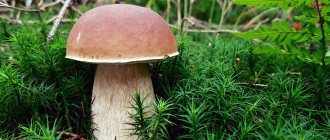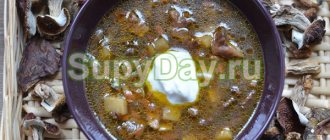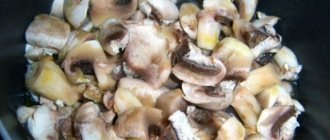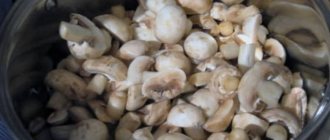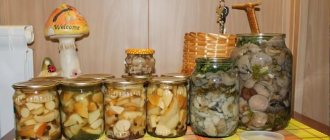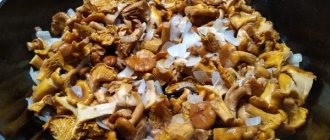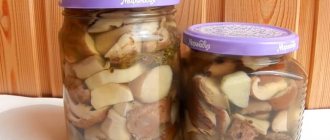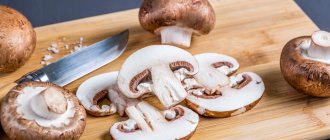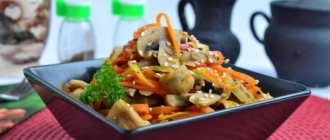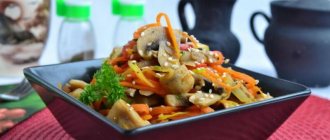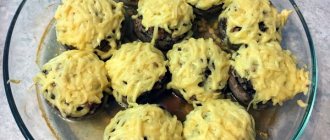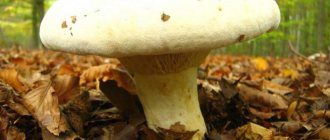Milkers appear in mixed Far Eastern forests in the second half of August. Lamellar mushrooms from the Russulaceae family (lat. Russulaceae) and the genus Milky (lat. Lact arius). Familiar and little-known, noble and not so noble.
All lactifers have fleshy and fragile bodies containing transparent or colored milky juice, which sometimes changes color when in contact with air. The presence of these properties is a systematic (that is, the most significant) feature. Hence the generic Latin name “milky”.
Ingredients
Various species of laticifers;
Coarse table salt - 50-60 g per 1 kg of boiled mushrooms. Garlic - 1-2 cloves per 1 kg of boiled mushrooms. Greens (or umbrellas) of dill, leaves of black currant, horseradish, oak. Details about mushrooms:
Any milkweed can be salted, since there are no poisonous species among them, and after salting, they are all quite edible. For pickling, we prefer to use small, young mushrooms with a tightly wrapped edge (photo 1).
The best in terms of taste: yellow milk mushrooms (Lactarius scrobiculatus), black milk mushrooms (Lactarius turpis) and white milk mushrooms (white milk mushrooms Russula delica) (white milk mushrooms are not laticifers, of course, but they are also very good when salted). Slightly worse than solyushka (Lactarius trivialis), milkweed (Lactarius torminosus and Lactarius pubescens), hollow milkweed (Lactarius rufus), and pepper milkmilk (Lactarius piperatus).
Third group: brown milkweed (Lactarius lignyotus), papillary milkweed (Lactarius mammosus), violin milkweed (Lactarius vellereus), silver milkweed (Lactarius flexuosus), camphor milkweed (Lactarius camphoratus), gray-pink (Lactarius helvus), faded milkweed (Lactarius vietus), brownish (Lactarius fuliginosus), lilac (Lactarius uvidus) and other small species.
In our area, worm-free mushrooms are practically never found (if you come across them, we salt them separately in a cold way), and there are no white milk mushrooms at all. The bulk of pickling mushrooms: nigella, volnushka, solyushka, duplyanka. Mushrooms from the third group make up no more than 25% of the total mass: we take them if there are no other mushrooms or only very beautiful young specimens. Camphor milkweeds retain their specific “aroma” when salted, so if you don’t like their smell, then it’s better not to take them.
Description
We clean the collected mushrooms from large debris, cut the stems short (under the cap) and put them in cold water for soaking. To ensure that the mushrooms are completely immersed in water, you can drown them with something - a plywood mug or even a plate. Soak for a day. During this time, it is good to change the water 1-2 times, at the same time carefully washing the mushrooms from adhering debris. During the soaking process, some mushrooms change their color: solyushki become yellow, and nigella become purple-burgundy. They retain these colors even in salting (in addition, in salting some mushrooms, for example, pepper milk mushrooms, the plates may acquire a greenish or bluish color: do not be alarmed - this is normal).
So, boil clean soaked mushrooms in unsalted water for 15 minutes from the moment of boiling. Cool directly in the broth.
Cook the leaves and herbs along the way (rinse with clean water), peel the garlic cloves. It is better to salt in an enamel bowl (you can use a glass container or a wooden tub). We salt in an enamel bucket (photo 2). The dishes for pickling should be thoroughly washed and scalded with boiling water. Enameled cookware should not have chipped enamel. Do not use aluminum or steel (stainless) cookware.
Place dill and leaves at the bottom of the container so that they cover the bottom. Place a layer of boiled mushrooms on them, plates facing up. There is no need to squeeze them out or let them flow around - let a little broth fall into the container. Sprinkle the layer evenly with coarse salt. At first, you can use scales (measure the amount of mushrooms and salt), but with some experience you can easily do this by eye. Place the second layer of mushrooms on the first layer and add salt again. And so on until all the mushrooms are placed (photo 3). While laying the mushrooms, add garlic cloves cut into 2-3 pieces. You shouldn’t get carried away with garlic - too much of it slows down the fermentation process. Cover the mushrooms with a layer of dill leaves and greens, place a wooden circle scalded with boiling water or (which is much simpler) a shallow porcelain plate of suitable size. Place a weight on a plate (or circle). We usually use a liter jar of water as a load. 1-2 cm of liquid should appear above the layer of leaves. Cover the entire structure with a clean cloth and put it in a cold place: a cellar or refrigerator (the temperature should not exceed 10 degrees Celsius; if it is higher, instead of the lactic acid fermentation process, we will get rotten mushrooms).
The correctness of salting (amount of salt and temperature) can be checked after a few days (about a week). Just smell the mushrooms and taste them. Mushrooms should have a pleasant sourish smell of fermentation and be moderately salted. If there is not enough salt (it tastes undersalted, and a musty smell may also appear), you can add salt water at the rate of 1.5-2 tablespoons of salt per 1 liter of cold boiled water. You should also add salt water if there is little liquid above the surface of the mushrooms. A musty smell may also indicate that the temperature is too high (more than 120 C).
The opposite situation: if you suddenly over-salt the mushrooms (they taste too salty, there is no smell of fermentation), in this case the mushrooms can be washed.
What’s good about the process of pickling mushrooms: you don’t have to try to fill the entire container at once, but do it gradually. We took a small portion and added salt, took more and added new layers. Just remember that the mushrooms will be ready no earlier than 30 days after laying the last layer.
During the salting process, you need to monitor the condition of the mushrooms. If mold appears on top, it must be removed. If there is not enough liquid above the mushrooms, add salted water. And also, once every 1-2 weeks, pierce the mass of mushrooms to the bottom of the container with a wooden spatula in two or three places.
What can you cook from them?
Sandbox is versatile in preparation - marinate, boil, salt, dry, fry. The only condition is to prepare this mushroom.
You need to process it like this:
- rinse each specimen under cold water;
- put the mushrooms in a deep bowl so that you can easily mix them;
- fill with very salty water and leave overnight;
- In the morning we mix the contents - the pores in the row have opened and sand will easily come out;
- carefully take out the mushrooms so as not to pick up fallen sand from the bottom;
- rinse again and fill with clean water;
- put on fire and after boiling, cook for 30 minutes;
- We change the water again and we can cook at our discretion.
How to cook
Have to take:
- sandpipers - 1 kg;
- water - 1 l;
- salt - 1 tsp;
- cloves - 2 pcs.;
- citric acid - on the tip of a knife.
How to cook:
- We pre-prepare the product.
- Pour water into the vessel, add salt, citric acid and bring to a boil.
- Place the sandboxes into boiling water.
- Cook for 20 minutes in a covered pan.
- Add seasonings and cook for another 20 minutes.
How to salt
You will need:
- sandpipers - 1 kg;
- garlic - 4 cloves;
- currant leaves - 6 pieces per 1 jar;
- pepper - 10 peas;
- salt - 50 g.
How to cook:
Place washed currant leaves in sterilized jars.
- We lay out the pre-prepared mushrooms in dense layers, sprinkling each one with salt and chopped garlic.
- You also need to cover the mushrooms with leaves on top to prevent them from becoming moldy.
- We close the jars and wait at least 6 weeks.
How to marinate
Needed:
- sandpipers - 1 kg;
- vinegar 6% - 3 tbsp. l.;
- sugar - 1 tbsp. l. with a slide;
- pepper - 5 peas;
- salt - 50 g;
- cloves and bay leaves - 2 pcs.
How to cook:
- Place the pre-prepared mushrooms in a saucepan and cook over low heat.
- Add all the ingredients.
- Keep on fire for another 20 minutes.
- Place the mushrooms tightly into the prepared jars.
- We close the jars and wait for them to cool, after which we store them in a cold room.
So, sandpipers are edible mushrooms that, when properly processed, can be a great snack. They can be confused with other species, so you need to collect them carefully and carefully. In addition to appearance, focus on the floury smell - you definitely won’t go wrong.
Milky
Milky fungi (Lactarius) are a separate genus of lamellar fungi, numbering a very large number of species. The most famous of them are milk mushrooms, saffron milk caps, and volushki. Their name comes from the Latin word, which means “milk” or “milk-giving.” All these mushrooms belong to the Russula family. As a rule, in Europe, most species of these mushrooms are considered inedible, and some are even poisonous. While in Russia many are consumed as food after undergoing additional processing, such as salting or pickling. Such mushrooms are called conditionally edible. The mushroom about which the story will go is exactly one of them - the common milkweed.
Where does the inedible milk mushroom grow?
Gray-pink milkweed is a mushroom that grows in swamps. It can be found among pines and birches, in mosses. It grows from August to September. When favorable conditions occur, there can be a lot of mushrooms.
In Russia, such a mushroom is often classified as conditionally edible. But in foreign literature it is defined as mildly poisonous. And in our country, such mushrooms are often considered inedible. It is worth noting that this species can be classified as low-value. Therefore, collecting milkweed makes sense in the complete absence of commercial varieties. Mushrooms have a very strong specific smell, which usually scares away mushroom pickers.
a brief description of
Common milkweed, smooth milkweed, spurge, hollow milkweed, milkweed, blue milk mushroom, smooth mushroom... This mushroom has quite a few names. It belongs to a large species of laticifers, the Russula family. The main difference between this kind of mushrooms is the secretion of juice by the pulp or spore-bearing layer, similar to milk. Milk plants have a specific bitter taste. Like many other representatives of this species, smoothie is considered a conditionally edible mushroom. Mycologists classified it as this species because it requires additional processing before use and has some limitations in preparation.
In European cuisine, where they like to use everything in its natural, raw form, the common milkweed is classified as a poisonous mushroom and is prohibited for consumption. And in our area, conditionally edible mushrooms are subjected to prolonged soaking, salting or repeated boiling, with repeated removal of the broth. And only then can such mushrooms be eaten.
The milkweed has a fairly wide cap, sometimes reaching up to 18 cm in diameter. One of its names - smoothie - was given precisely because of its smooth, fleshy cap. When it rains it becomes slippery. In young mushrooms it is more convex, but with age it settles and becomes depressed. The color varies from violet-lilac to fawn or even fawn-brown. In older varieties it fades and becomes pale lilac or yellowish-brown with barely visible concentric zones, or without them at all. The leg is smooth, cylindrical in shape. Has the same color as the hat. With age, it loosens and becomes hollow. The laticifer's plates are often light-colored; when damaged, they acquire a dark grayish color, mainly due to the milky sap. The pulp of the smoothie is dense, strong, white in color with a slight creamy tint. The juice released from it is white and milky in color. When dry it turns olive yellow. The pulp is very bitter in taste and has a specific smell. The spores are elliptical with ridge-like or warty ornamentation. The spore powder is pale, yellowish or cream in color.
Gorkushka
Bittersweet – lat. Lactarius rufus
This mushroom is otherwise called Goryanka, Putik, Pepper Milkweed, Red Bittersweet, Bitter Milk or Gorchak.
Description
Mushroom cap
The diameter of Gorchak's cap reaches 10-12 cm. In young mushrooms, it grows convexly - pointed, with a mound in the middle. The hats of older specimens become flat, the edges bend inward, the mound remains, and the central part is slightly pressed in.
The “headdress” is covered with a red-brown skin, shiny and sticky during rains and dry and matte on fine days.
The caps are filled with tight, fragile white or pale brown pulp, which darkens as the Pepper Milk grows older. It is so juicy that if you break the mushroom, a lot of white, bitter-sharp juice will immediately be released, which does not darken over time.
The bottom of the hat is decorated with frequent narrow plates, slightly descending to the stem. Young mushrooms have reddish-yellow, dim plates, mature ones are pale brown, old mushrooms are brown, with a whitish coating.
The fungus reproduces by whitish, oval, net-like spores contained in a white spore powder.
Stipe
Bittersweet is endowed with an almost smooth (with barely noticeable fluff), not curved cylindrical stem, the height of which reaches 80 mm, thickness - 15 mm. Adult mushrooms have stems with cavities inside.
The stem of a young mushroom is almost white; in an adult mushroom it is colored to match the cap, but it can be somewhat paler - pinkish, reddish or slightly reddish.
Places of growth and fruiting
The milkweed grows well in any forest with a good litter layer, but is more often found in pine forests with a mossy substrate and birch forests with lichens. The main thing is not to collect it near highways or near industrial facilities, as bitters easily accumulate toxic substances.
A rare wormy fungus, it is born in June and bears fruit until the end of September, since it is not afraid of frost.
Edibility
Red bittersweet is recognized as an edible mushroom, belonging to the 4th category of edibility. The bitter pulp, slightly smelling of wood, becomes very tasty after cooking.
Before salting or pickling mushrooms, they must be soaked or boiled to remove the bitterness. After salting, the mushrooms turn dark brown. Only young mushrooms with tender flesh are marinated; spices are added to brines and marinades.
Some gourmets fry the Pepper Milk, but only after boiling.
Bittersweet – lat. Lactarius rufus
Similar types and differences from them
Edible
- Camphor milkweed. It is distinguished by the smell of dry roots, while the bittersweet has a woody aroma.
- Swamp milk mushroom. There is no mound on its cap, and the mushroom itself chooses for growth exclusively spruce and pine forests located in wetlands.
- The breast is orange. It is distinguished by a faintly noticeable bitter taste, has a tight cap of a reddish-chestnut hue with a darkish center and a stem of the same color.
Inedible
Milky liver. Unlike the juice of Gorkushka, which does not change color in the air, the juice of the liver milk becomes yellow.
Distribution areas and similar species
Smoothies are widespread in deciduous and coniferous forests of Eurasia.
They often form mycorrhiza with trees such as spruce, pine or birch. They love high humidity, so they can often be found in large groups along swamps or on moss-covered soil, where conditions for growth and reproduction are most optimal. The common milkweed is one of the most common species of the genus of milkweeds. It grows in temperate latitudes, so it can be found with equal success in the forests of Europe, Siberia, the Urals, and even the Far East. The peak of fruiting of the smoothie occurs at the beginning of August and lasts until the end of October - the time when the greatest amount of precipitation falls. Cool autumn evenings, filled with the fresh aroma of warm rain, are their favorite time to appear. Gladysh, or common milkweed, is a fairly recognizable mushroom, but it is often confused with such representatives of the same species as the gray milkweed (Lactarius flexuosus) and the red milkweed (Lactarius hysginus). But if you look closely, you can note some differences that are not immediately obvious. So, for example, the surface of the cap of the serushka is dry to the touch, the stem is solid, narrowed towards the base, and short. It tastes much sharper and sharper. And the meat-red milkweed is distinguished by its dark, terracotta color and pungent strong aroma. Gladysh also has similarities with the flaccid milkweed (Lactarius vietus), the juice of which turns gray under the influence of the external environment. And also with the gray lilac milky (Lactarius uvidus), the juice of which in the air acquires a lilac-violet hue.
Cracker doubles
Bittersweet has quite a lot of doubles. In order to distinguish it from them, it is necessary to know the structural features of each. Fortunately, bittersweet is a mushroom that has no poisonous counterparts, which means you are safe. But still, it is necessary to distinguish her from other inhabitants of the forest. Let's find out who the bitter one looks like and with whom it can still be confused.
Camphor milk mushroom
Bitter mushroom is very often confused with camphor mushroom, largely because these two mushrooms have almost identical colors. However, there is still a significant difference. The breast has a darker cap, and at the same time, more slimy. If there is not much mucus on the bitter mushroom, then there is an excess of it on the milk mushroom. Therefore, many people unknowingly confuse these mushrooms, and then wonder why the milk mushroom has become so peppery.
In order to distinguish these mushrooms, just look at their flesh. In milk mushrooms, the flesh has a light tint, while in bitter mushrooms, when it interacts with oxygen, it becomes dark. This is the main difference.
Composition and beneficial properties
The nutritional value of mushrooms depends on many different conditions. For example, young varieties contain much more nutrients, and fresh ones contain almost 90% water. The proteins of the milkweed contain such valuable amino acids as: tyrosine, glutamine, leucine and arginine. They are easily absorbed by the body and do not spend much money on breakdown. Mushroom fats contain such a useful substance as lecithin. Their number ranges from 0.1 to 0.9%. They also contain fatty acids:
- palmitic acid;
- stearic acid;
- butyric acid;
- acetic acid.
Milkweeds, like other representatives of this genus, contain phosphatides, essential oils and lipoids. In terms of carbohydrate composition, mushrooms are very close to vegetables, but there are others that are characteristic only of this class: glycogen, sugar alcohols, fiber. Their content reaches 16%. They do not contain starch, but they do contain glycogen, which in its composition resembles glycogen of animal origin. In mineral composition, laticifers are rich in potassium, phosphorus and calcium. They also contain trace elements such as iodine, zinc, copper and arsenic. They also contain substances such as mycoinulin and parodextrin, which are responsible for covering the mushrooms with mucus during long-term storage, as well as tregazolyte and lycosote, which provide their taste and nutritional value.
Use in cooking
Common milkweed is a first-class mushroom for pickling and pickling. During this processing, fermentation quickly occurs in it, due to which the smoothie acquires its characteristic sourish taste, which is so valued in Russian pickles. The mushroom is quite meaty, which allows it to be used after preliminary boiling for preparing various dishes. Most of the bitterness of the milkweed disappears during heat treatment, so well-fried mushrooms can also be eaten without subjecting them to cooking beforehand. In the finished dish, such smoothies will have a piquant, spicy, slightly bitter taste, like mushrooms seasoned with black pepper. Northern peoples have long revered this mushroom and often use it for culinary purposes. After all, their natural bitter taste repels pests, so milkweeds are less susceptible to attack by insect larvae and worms than other mushrooms. And since ancient times, Finland has had its own original recipe for making smoothies baked over a fire or grill.
Salting the common milkweed
Immediately before pickling, mushrooms should be soaked in water for several days. The infused water must be changed periodically. This is done in order to remove the bitterness. After this, the milkies are blanched for about 10 minutes. The correct course of the primary processing process is important, since its violation can lead to unnecessary consequences in the form of loss of the taste of the mushroom or intestinal upset. Cold and hot methods are used for salting the common milkweed. Hot is characterized by preliminary boiling of mushrooms after primary processing. The cold method skips this process.
Mushrooms in Korean
To prepare the dish you will need:
- smoothies or other bitter mushrooms;
- soy sauce;
- sugar;
- vinegar;
- ground coriander;
- garlic;
- hot red pepper;
- sesame;
- cilantro.
First boil the mushrooms several times, draining the processed water. It is advisable to leave a slight bitter aftertaste for piquancy. Season the prepared milkweed with soy sauce, add sugar and sprinkle with vinegar. Mix all this and taste the marinade to adjust the taste. Then sprinkle generously with spices. Pre-fry the sesame seeds in vegetable oil and pour the resulting mixture into the mushrooms. Add fresh green cilantro, mix everything and cool. After this, the Korean mushrooms are ready and can be served. Regular, non-bitter mushrooms are not suitable for this recipe, since having their own delicate taste, they will simply get lost in the spices and the dish will not give the desired taste and effect.
Collection and storage
It is good to pick mushrooms in dry weather, since if collected in rain or damp conditions, they can spoil faster. It is best to do this in the morning, when their aroma is stronger and their structure is stronger.
Mushroom pickers must comply with several conditions:
- collect only known types of mushrooms;
- use wicker baskets in which the mushrooms are well ventilated and remain fresh longer;
- lay with their caps down, and long-legged ones sideways.
- When collecting, twist or swing, then they are easier to separate.
It must be remembered that cutting mushrooms with a knife is not recommended, otherwise this may lead to rotting of the entire mycelium.
Fresh mushrooms are a perishable product. They need to be stored in a cool, ventilated area, or in the fresh air under a canopy. Usually they are scattered in a thin layer on a specially prepared surface: on tables, clean flooring, tarpaulin. They should not be piled up, kept in barrels, or exposed to direct sunlight or high humidity. The shelf life of milkweeds before pre-treatment should not exceed four hours.
How to store salted mushrooms?
It is important not only to properly prepare the snack, but also to store salted mushrooms at home in accordance with all requirements.
- Salted mushrooms are often stored in the same container in which the salting process took place. In some cases, the workpiece is transferred to jars, making sure that the fruits are completely covered with brine.
- For better preservation, a layer of calcined and cooled vegetable oil is often poured into the container with the workpiece.
- For long-term storage, the snack is placed in a cool room with a constant temperature of +1 to +5 degrees. This could be a refrigerator or a cool cellar.
- You cannot store mushrooms, or pickle them, in metal or clay containers. Ideal containers are wooden barrels, tubs, enamel or glass containers. When choosing enamel dishes, check the integrity of the enamel and at the slightest hint of chips, look for another vessel.
conclusions
Common milkweed, or gladysh, is a mushroom that can only be appreciated by true mushroom pickers or gourmets. But if you prepare it correctly, using preliminary primary processing of the product, it can make itself loved by the average consumer. It turns out divine when salted, but requires a long and labor-intensive preparation process. These mushrooms bear fruit for quite a long time, when other mushrooms have already faded, so in fact they have no competitors. And thanks to their high yield, they often appear on the tables of hospitable hosts and even on store shelves.
Some of the representatives of the lacticifer species have found widespread use in modern medicine. Valuable antibiotics are extracted from their milky juice, which help in the treatment of dangerous diseases such as tuberculosis and staphylococcus. Also, their beneficial properties make it possible to fight purulent eye infections and are effective against cholelithiasis.
It is important to remember how to properly collect and store these mushrooms so as not to expose yourself to the risk of poisoning or cause an eating disorder. And also, do not forget that in European countries this mushroom is considered poisonous, and only thanks to careful primary processing is it allowed to be consumed in our regions.
Additional Information
It is also possible to recover deleted files from Honor and Huawei phones directly through the channels through which the backup was created. For Huawei, this is Huawei Backup.
You re-authorize through the account through which the backup was created.
How to turn on, reboot, turn off Honor Band 5: instructions for the first time
What to do if you forgot the password for the backup file?
It is possible to recover the password through the linked phone number or email. However, if you restore several times in a row, the system may perceive you as a hacker and block your account forever.
What is Emergency Backup?
This is an emergency backup feature. It occurs when you have lost access to your phone and want to urgently restore components.
